The
Library History Buff
Promoting the appreciation, enjoyment, and preservation of library history
The
Catalogue Cards of the Harvard College Library
I have an interest in catalog cards and card catalog
cabinets that is reflected in both the
Library History Buff Blog and the Library
History Buff website. Allen Veaner, the former
Director of Libraries at the University of California at Santa Barbara, became
aware of my interest in library history and contacted me to see if I would be
interested in a collection of "catalogue" cards that he had salvaged from his time
as a cataloguer at the Widener Library of Harvard University. I, of course, said yes. The collection
was of particular interest to me because of the role that Harvard played in the
early adoption of the card catalog by libraries in the United States and by its
use of a 2
inch by 3 inch catalog card instead of what became the universal standard 7.5 x
12.5 cm catalog card. Allen's collection consisted of five of the 2 x 3 inch
cards, 42 standard size cards, and three order cards. Below is an essay about
the collection which he was kind enough to provide with the collection. I have included
scans of some of the cards. Click
here for a historical overview of the card
catalog. Click here
for examples and uses of card catalog cabinets. Click
here for
examples and uses of old catalog cards. For more information on early library
catalogs in Boston libraries read: Mitchell, Barbara A. "Boston Library
Catalogues, 1850-1875 Female Labor and Technological Change," in Augst and
Carpenter, eds. Institutions of Reading: The Social Life of Libraries in the
United States (University of Massachusetts Press, 2007), pp. 119-147.
In the Days of Card Catalogues: A Brief Portrait
by Allen B. Veaner
June, 2009
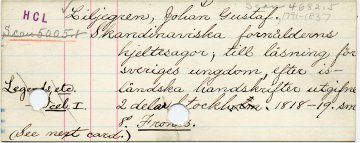
Modern librarians are so accustomed to online systems that most recent
professionals have little or no experience with card catalogs. Here I relate a
few anecdotes about file management in the card era. I hope they will illustrate
the distance we have traveled. The scope of my essay is confined solely to my
experience in Widener library, Harvard University. For two years, 1957-59, I was
a junior cataloguer at Widener, responsible only for descriptive cataloguing;
others—much more senior staff—took care of subject cataloguing and
classification. In my limited capacity one of my duties was troubleshooting
problem entries and resolving inconsistencies in the bibliographic record. Very
often I worked with some quite old catalogue cards, some of which predated
universal acceptance of Melvil Dewey’s 75 mm x 125 mm format.
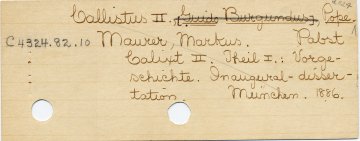
This brief account of my experiences accompanies actual specimens of old,
original catalogue records from Widener Library’s Official Catalogue. When old
records of non-standard size or format were replaced with modern, standard size
records, it was customary to discard the superseded records. However, I
sometimes retained these old records as historical curiosities and now (June,
2009) I am giving them to Larry Nix, well-known library history buff.
Incidentally, fifty years ago Harvard maintained the traditional spelling of
catalogue with the "ue" from the British spelling. I am maintaining that
tradition in this account.
There were two major card catalogues in Widener Library: a Public Catalogue (PC)
on the library’s main floor (the second floor) and an Official Catalogue (OC) on
the first floor where the Catalogue Department’s offices and work areas were
located. As a union catalogue, the OC theoretically contained a main entry for
every title held by the University’s library system, which at that time
comprised nearly a hundred units among Harvard’s branch libraries within the
Faculty of Arts & Sciences, and within the various professional schools (law,
medicine, and others). Libraries outside the administrative jurisdiction of the
Harvard College Library (HCL) did their own cataloging and were responsible for
sending a main entry card to the OC so there could be one place to search for
all holdings of all Harvard libraries.
Changes made in the OC would sometimes require extensive changes to the PC. The
PC held main, title, subject, and sometimes other secondary entries, for
holdings under the jurisdiction of HCL, but not for the libraries of the
professional schools or certain specialized academic units. Holdings of the
entire University Library system were reflected only in the OC, and only by
their main entries. When I replaced an antique OC record of an item also
recorded in the PC, it was necessary to prepare new card sets for the PC to
cover revised title, subject, series, and other entries. Very rarely, a problem
required reclassification. Only the head or assistant head of the Catalogue
Department made the reclassification decision.
Many times it was essential to examine the work itself. Typically, a campus
messenger service took care of bringing distant items to Widener Library so that
I could have the book in hand to prepare a revised entry.

Not all cataloguing was original. Catalogue entries were accepted from several
sources and often modified to suit local need. Among the surviving antiques are
handwritten cards about 1 & 7/8” high and 4 & 15/16” long. Some cards of this
same size bear entries locally printed at Harvard’s Printing Office; locally
printed cards are identifiable by the initials HCL, (“HCL” is also rubber
stamped on some entries for locational assistance.) Locally printed cards bear
numbers similar in style to those on printed LC cards: the last two digits of a
year followed by a sequence number. Besides cards printed at Harvard, HCL
accepted cards from other sources:
Boston Public Library. (Some BPL entries provide the exact date of printing.)
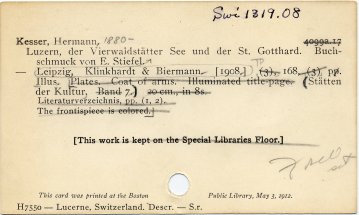
New York Public Library, Schiff Collection (Hebraica)
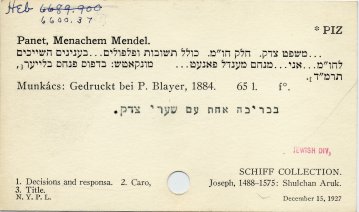
Library of Congress. LC cards were liberally annotated or altered, and very
often a “proof” LC card printed on thin, cheap paper found its way into the OC.
Entries cut from vendor catalogues and pasted onto card stock.
In Widener Library, and in other units administered as part of HCL, Harvard used
its own classification system until the switchover to LC. Harvard’s alphanumeric
classification system was heavily mnemonic, typically starting with an obvious
abbreviation for a major category, e.g., Ger = German history and culture, LSoc
= journals of learned societies. On the cards, all call numbers were formatted
horizontally, never stacked. This was intended as a space saving device with the
goal of cutting down on the growth rate of the catalogue and thus putting off
the need to buy additional expensive cabinetry.
OC entries indicated tracings on the back for generating additional subject and
title entries intended for the PC. An asterisk preceding a subject heading
informed the typist that an additional set of cards would be needed for a
subject entry. Prior to the adoption of offset printing late in the 1950s, all
card sets were individually typed and proofed. In the 1960s the Widener
Library’s Photographic Department took over all card reproduction, employing the
services of the then modern, high speed Xerox Copyflo printer. (The Copyflo
system for card reproduction is fully described in my article, “Library Card
Reproduction by Xerox Copyflo,” in Library Resources & Technical Services,
8(3):279-284 Summer 1964.)
The library generated series entries only on a selective basis. If no series
entry was to be provided, a main entry card that bore series information was
marked on the back with a tracing: srnk = series record not kept.
In numerous cases, especially with handwritten cards, a call number was added in
pencil and in a different hand. This suggests that earlier in the library’s
history—before the Widener building was constructed—books might have been
shelved by size or were arranged in fixed locations.
Sometimes the only change to a record was the substitution of a printed for a
handwritten card. In such instances, the legend “Substituted card” was
handwritten on the new card.
If an earlier entry was so hopelessly mixed up or new information suggested a
complete reorganization of the bibliographic record was desirable or, for
whatever reason, existing cards could not be salvaged, a new entry was required.
In such cases I would prepare a new, handwritten entry citing other authorities
and catalogues, such as BM for British Museum, BN for Bibliothèque Nationale,
etc., plus arguments of my own in support of an entire reorganization of the
bibliographic record. One such entry (for Gubernatis, LC 7-39363) is included
with the materials I am forwarding to Larry Nix.
Typically, subject cards for the PC had their subject headings typed with a red
ribbon. After bi-color ribbons became too expensive or harder to obtain, subject
heading were simply typed entirely in upper case.
Sometimes an entry was clipped from a bookseller’s catalogue and directly
imported into the OC. Other times a copy of an order slip became the Official
Catalogue’s entry. Included in this collection are a few order slips, each about
2.75” x 6.75”. One bears a “received” date of February 8, 1882 and the other
July 6, 1908. The latter’s bibliographic information was taken directly from a
vendor’s printed catalogue and pasted onto the order slip. Thus, informal
records migrated into the OC. Probably the intention was to generate permanent,
formal bibliographic records later, but this was never done.
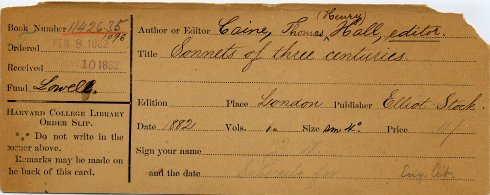
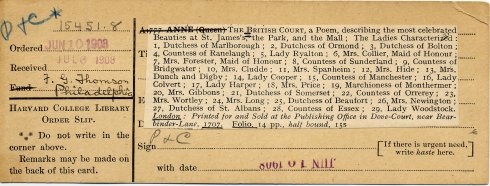
To avoid fatigue and consequent errors, and as an aid to learning the catalogue,
all new professional employees and selected support staff were assigned to file
cards into the OC. Filing duty was limited to a few hours a day and would run
for several months. New filers were required to file “on the rod” so that
supervisor could first check the accuracy of filing before the rod was withdrawn
and the cards lowered into place.
The entire process was a great learning experience. It taught me to know and
appreciate that the card catalogues of great university libraries were indeed
powerful research instruments. I suspect that those that remain still are.
This site created and maintained
by
Larry T. Nix
Send comments or questions to
nix@libraryhistorybuff.org
Last updated: 06-27-09
© 2005-2009 Larry T. Nix






